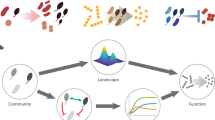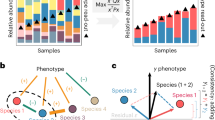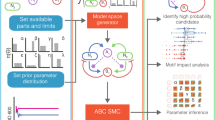Abstract
Recent meta-analyses suggest that ecosystem functioning increases with biodiversity, but contradictory results have been presented for some microbial functions. Moreover, observations of only one function underestimate the functional role of diversity because of species-specific trade-offs in the ability to carry out different functions. We examined multiple functions in batch cultures of natural freshwater bacterial communities with different richness, achieved by a dilution-to-extinction approach. Community composition was assessed by molecular fingerprinting of 16S rRNA and chitinase genes, representing the total community and a trait characteristic for a functional group, respectively. Richness was positively related to abundance and biomass, negatively correlated to cell volumes and unrelated to maximum intrinsic growth rate. The response of chitin and cellulose degradation rates depended on the presence of a single phylotype. We suggest that species identity and community composition rather than richness matters for specific microbial processes.
Similar content being viewed by others
Log in or create a free account to read this content
Gain free access to this article, as well as selected content from this journal and more on nature.com
or
Accession codes
References
Acinas SG, RodriguezValera F, PedrosAlio C . (1997). Spatial and temporal variation in marine bacterioplankton diversity as shown by RFLP fingerprinting of PCR amplified 16S rDNA. FEMS Microbiol Ecol 24: 27–40.
Ammerman JW, Fuhrman JA, Hagstrom A, Azam F . (1984). Bacterioplankton growth in seawater. 1. Growth-kinetics and cellular characteristics in seawater cultures. Mar Ecol-Prog Ser 18: 31–39.
Balvanera P, Pfisterer AB, Buchmann N, He JS, Nakashizuka T, Raffaelli D et al. (2006). Quantifying the evidence for biodiversity effects on ecosystem functioning and services. Ecol Lett 9: 1146–1156.
Bell T, Newman JA, Silverman BW, Turner SL, Lilley AK . (2005). The contribution of species richness and composition to bacterial services. Nature 436: 1157–1160.
Bent SJ, Pierson JD, Forney LJ . (2007). Measuring species richness based on microbial community fingerprints: the emperor has no clothes. Appl Environ Microbiol 73: 2399–2401.
Cardinale BJ, Srivastava DS, Duffy JE, Wright JP, Downing AL, Sankaran M et al. (2006). Effects of biodiversity on the functioning of trophic groups and ecosystems. Nature 443: 989–992.
Covich AP, Austen MC, Bärlocher F, Chauvet E, Cardinale BJ, Biles CL et al. (2004). The role of biodiversity in the functioning of freshwater and marine benthic ecosystems. Bioscience 54: 767–775.
Degens BP . (1998). Decreases in microbial functional diversity do not result in corresponding changes in decomposition under different moisture conditions. Soil Biol Biochem 30: 1989–2000.
del Giorgio P, Bird DF, Prairie YT, Planas D . (1996). Flow cytometric determination of bacterial abundance in lake plankton with the green nucleic acid stain SYTO 13. Limnol Oceanogr 41: 783–789.
Downing AL . (2005). Relative effects of species composition and richness on ecosystem properties in ponds. Ecology 86: 701–715.
Eiler A, Bertilsson S . (2004). Composition of freshwater bacterial communities associated with cyanobacterial blooms in four Swedish lakes. Environ Microbiol 6: 1228–1243.
Franklin RB, Garland JL, Bolster CH, Mills AL . (2001). Impact of dilution on microbial community structure and functional potential: comparison of numerical simulations and batch culture experiments. Appl Environ Microbiol 67: 702–712.
Fuchs BM, Zubkov MV, Sahm K, Burkill PH, Amann R . (2000). Changes in community composition during dilution cultures of marine bacterioplankton as assessed by flow cytometric and molecular biological techniques. Environ Microbiol 2: 191–201.
Fukami T, Morin PJ . (2003). Productivity–biodiversity relationships depend on the history of community assembly. Nature 424: 423–426.
Gamfeldt L, Hillebrand H, Jonsson PR . (2008). Multiple functions increase the importance of biodiversity for overall ecosystem functioning. Ecology 89: 1223–1231.
Gasol JM, Comerma M, Garcia JC, Armengol J, Casamayor EO, Kojecka P et al. (2002). A transplant experiment to identify the factors controlling bacterial abundance, activity, production, and community composition in a eutrophic canyon-shaped reservoir. Limnol Oceanogr 47: 62–77.
Giller PS, Hillebrand H, Berninger UG, Gessner MO, Hawkins S, Inchausti P et al. (2004). Biodiversity effects on ecosystem functioning: emerging issues and their experimental test in aquatic environments. Oikos 104: 423–436.
Griffiths BS, Kuan HL, Ritz K, Glover LA, McCaig AE, Fenwick C . (2004). The relationship between microbial community structure and functional stability, tested experimentally in an upland pasture soil. Microb Ecol 47: 104–113.
Griffiths BS, Ritz K, Bardgett RD, Cook R, Christensen S, Ekelund F et al. (2000). Ecosystem response of pasture soil communities to fumigation-induced microbial diversity reductions: an examination of the biodiversity–ecosystem function relationship. Oikos 90: 279–294.
Hammer Ø, Harper DAT, Ryan PD . (2001). PAST: paleontological statistics software package for education and data analysis. Palaeontol Electron 4: 9.
Hector A, Bagchi R . (2007). Biodiversity and ecosystem multifunctionality. Nature 448: 188–190.
Hillebrand H, Cardinale BJ . (2004). Consumer effects decline with prey diversity. Ecol Lett 7: 192–201.
Hillebrand H, Matthiessen B . (2009). Biodiversity in a complex world: consolidation and progress in functional biodiversity research. Ecol Lett 12: 1405–1419.
Hillebrand H, Watermann F, Karez R, Berninger UG . (2001). Differences in species richness patterns between unicellular and multicellular organisms. Oecologia 126: 114–124.
Hobel CFV, Marteinsson VT, Hreggvidsson GO, Kristjansson JK . (2005). Investigation of the microbial ecology of intertidal hot springs by using diversity analysis of 16S rRNA and chitinase genes. Appl Environ Microbiol 71: 2771–2776.
Jaspers E, Overmann J . (2004). Ecological significance of microdiversity: identical 16S rRNA gene sequences can be found in bacteria with highly divergent genomes and ecophysiologies. Appl Environ Microbiol 70: 4831–4839.
Jiang L . (2007). Negative selection effects suppress relationships between bacterial diversity and ecosystem functioning. Ecology 88: 1075–1085.
Langenheder S, Lindström ES, Tranvik LJ . (2005). Weak coupling between community composition and functioning of aquatic bacteria. Limnol Oceanogr 50: 957–967.
Langenheder S, Lindström ES, Tranvik LJ . (2006). Structure and function of bacterial communities emerging from different sources under identical conditions. Appl Environ Microbiol 72: 212–220.
Lawton JH . (1994). What do species do in ecosystems. Oikos 71: 367–374.
Liu WT, Marsh TL, Cheng H, Forney LJ . (1997). Characterization of microbial diversity by determining terminal restriction fragment length polymorphisms of genes encoding 16S rRNA. Appl Environ Microbiol 63: 4516–4522.
McGrady-Steed J, Harris PM, Morin PJ . (1997). Biodiversity regulates ecosystem predictability. Nature 390: 162–165.
McGrady-Steed J, Morin PJ . (2000). Biodiversity, density compensation, and the dynamics of populations and functional groups. Ecology 81: 361–373.
Mikola J, Setala H . (1998). Relating species diversity to ecosystem functioning: mechanistic backgrounds and experimental approach with a decomposer food web. Oikos 83: 180–194.
Montgomery MT, Kirchman D . (1993). Estimating degradation rates of chitin in aquatic samples. In: Kemp PF, Sherr BF, Sherr BE, Cole JJ (eds). Handbook of Methods in Aquatic Microbial Ecology. Lewis Publishers: London, pp 597–600.
Morin PJ, McGrady-Steed J . (2004). Biodiversity and ecosystem functioning in aquatic microbial systems: a new analysis of temporal variation and species richness-predictability relations. Oikos 104: 458–466.
Naeem S, Li SB . (1997). Biodiversity enhances ecosystem reliability. Nature 390: 507–509.
Perdue EM . (2009). Natural organic matter. In: Likens GE (ed). Encyclopedia of Inland Waters. Elsevier Academic Press: Oxford, UK, pp 806–819.
Petchey OL, Gaston KJ . (2006). Functional diversity: back to basics and looking forward. Ecol Lett 9: 741–758.
Petchey OL, Morin PJ, Hulot F, Loreau M, McGrady-Steed J, Naeem S . (2002). Contributions of aquatic model systems to our understanding of biodiversity and ecosystem functioning. In: Loreau M, Naeem S, Inchausti P (eds). Biodiversity and Ecosystem Functioning. Oxford University Press: Oxford, pp 127–138.
Posch T, Loferer-Krossbacher M, Gao G, Alfreider A, Pernthaler J, Psenner R . (2001). Precision of bacterioplankton biomass determination: a comparison of two fluorescent dyes, and of allometric and linear volume-to-carbon conversion factors. Aquat Microb Ecol 25: 55–63.
Prosser JI, Bohannan BJM, Curtis TP, Ellis RJ, Firestone MK, Freckleton RP et al. (2007). Essay—the role of ecological theory in microbial ecology. Nat Rev Microbiol 5: 384–392.
Reiss J, Bridle JR, Montoya JM, Woodward G . (2009). Emerging horizons in biodiversity and ecosystem functioning research. Trends Ecol Evol 24: 505–514.
Szabo KE, Itor POB, Bertilsson S, Tranvik L, Eiler A . (2007). Importance of rare and abundant populations for the structure and functional potential of freshwater bacterial communities. Aquat Microb Ecol 47: 1–10.
Thingstad TF, Ovreas L, Egge JK, Lovdal T, Heldal M . (2005). Use of non-limiting substrates to increase size; a generic strategy to simultaneously optimize uptake and minimize predation in pelagic osmotrophs? Ecol Lett 8: 675–682.
Tranvik LJ, Höfle MG . (1987). Bacterial-growth in mixed cultures on dissolved organic-carbon from humic and clear waters. Appl Environ Microbiol 53: 482–488.
Violle C, Navas ML, Vile D, Kazakou E, Fortunel C, Hummel I et al. (2007). Let the concept of trait be functional!. Oikos 116: 882–892.
Wertz S, Degrange V, Prosser JI, Poly F, Commeaux C, Guillaumaud N et al. (2007). Decline of soil microbial diversity does not influence the resistance and resilience of key soil microbial functional groups following a model disturbance. Environ Microbiol 9: 2211–2219.
Acknowledgements
This study was funded by the Swedish Research Council Formas by UMC (Uppsala Microbiomics Centre) and grants from the Swedish Research Council to LT and StB. Comments from two anonymous reviewers improved the manuscript.
Author information
Authors and Affiliations
Corresponding author
Rights and permissions
About this article
Cite this article
Peter, H., Beier, S., Bertilsson, S. et al. Function-specific response to depletion of microbial diversity. ISME J 5, 351–361 (2011). https://doi.org/10.1038/ismej.2010.119
Received:
Revised:
Accepted:
Published:
Issue date:
DOI: https://doi.org/10.1038/ismej.2010.119
Keywords
This article is cited by
-
The rhizosphere Microbiome of Malus sieversii (Ldb.) Roem. in the geographic and environmental gradients of China's Xinjiang
BMC Microbiology (2023)
-
The selection of copiotrophs may complicate biodiversity-ecosystem functioning relationships in microbial dilution-to-extinction experiments
Environmental Microbiome (2023)
-
Will free-living microbial community composition drive biogeochemical responses to global change?
Biogeochemistry (2023)
-
Vegetation–soil–microbial diversity influences ecosystem multifunctionality across different tropical coastal ecosystem types
Tropical Ecology (2022)
-
Engineering complex communities by directed evolution
Nature Ecology & Evolution (2021)



